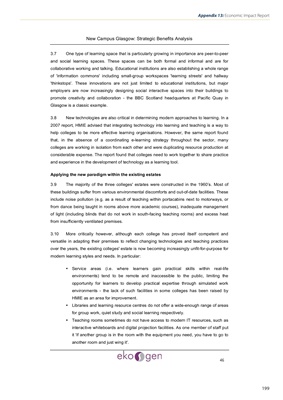
New Campus Glasgow: Strategic Benefits Analysis
46
3.7 One type of learning space that is particularly growing in importance are peer-to-peer
and social learning spaces. These spaces can be both formal and informal and are for
collaborative working and talking. Educational institutions are also establishing a whole range
of 'information commons' including small-group workspaces 'learning streets' and hallway
'thinkstops'. These innovations are not just limited to educational institutions, but major
employers are now increasingly designing social interactive spaces into their buildings to
promote creativity and collaboration - the BBC Scotland headquarters at Pacific Quay in
Glasgow is a classic example.
3.8 New technologies are also critical in determining modern approaches to learning. In a
2007 report, HMIE advised that integrating technology into learning and teaching is a way to
help colleges to be more effective learning organisations. However, the same report found
that, in the absence of a coordinating e-learning strategy throughout the sector, many
colleges are working in isolation from each other and were duplicating resource production at
considerable expense. The report found that colleges need to work together to share practice
and experience in the development of technology as a learning tool.
Applying the new paradigm within the existing estates
3.9 The majority of the three colleges' estates were constructed in the 1960's. Most of
these buildings suffer from various environmental discomforts and out-of-date facilities. These
include noise pollution (e.g. as a result of teaching within portacabins next to motorways, or
from dance being taught in rooms above more academic courses), inadequate management
of light (including blinds that do not work in south-facing teaching rooms) and excess heat
from insufficiently ventilated premises.
3.10 More critically however, although each college has proved itself competent and
versatile in adapting their premises to reflect changing technologies and teaching practices
over the years, the existing colleges' estate is now becoming increasingly unfit-for-purpose for
modern learning styles and needs. In particular:
• Service areas (i.e. where learners gain practical skills within real-life
environments) tend to be remote and inaccessible to the public, limiting the
opportunity for learners to develop practical expertise through simulated work
environments - the lack of such facilities in some colleges has been raised by
HMIE as an area for improvement.
• Libraries and learning resource centres do not offer a wide-enough range of areas
for group work, quiet study and social learning respectively.
• Teaching rooms sometimes do not have access to modern IT resources, such as
interactive whiteboards and digital projection facilities. As one member of staff put
it 'if another group is in the room with the equipment you need, you have to go to
another room and just wing it'.
199
Appendix 13: Economic Impact Report